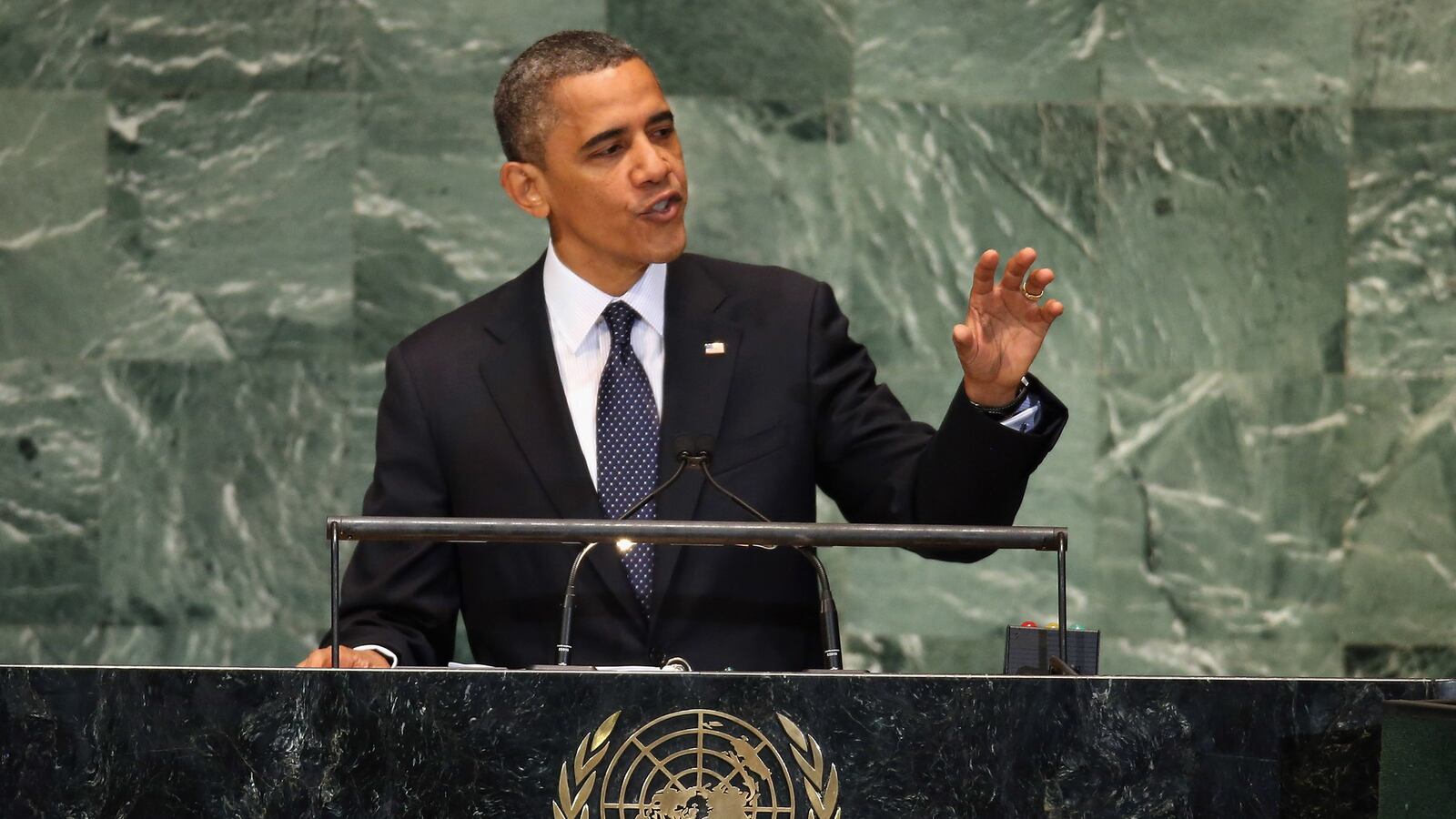A U.S. diplomat once spoke with bitterness of the breadth of his power when negotiating with an uncooperative dictator. “We will go after you with the full force of the law,” he said.
The diplomat then demonstrated with his hands what that looks like: a fluttering piece of paper, on which such laws are written, while saying, “Whoosh, whoosh, whoosh.”
No threat of firepower, no action, he said.
That’s the Achilles’ heel in the new U.N. resolution to combat the flow of foreign fighters to terrorist groups like ISIS. President Barack Obama will personally champion the resolution at the U.N. Security Council on Wednesday—only the second time a U.S. president chaired a meeting of the Security Council. (The first was when Obama chaired it in 2009.)
Members are expected to agree that foreign terrorist fighters should be stopped, but not to punitive measures for failing—or refusing—to stop them.
What the resolution would do, however, is take the onus of the Islamic State fight off the United States, and put it on the United Nations to track ISIS and all militants the U.N. Security Council can agree are terrorists.
“What we’re really trying to do is to up our game as to what is being shared” by “elevating the collective nature of the threat,” an administration official said Monday.
Shifting responsibility to the U.N. could make it easier for some countries to crack down on militancy, and avoid being called U.S. stooges for doing so, said one congressional aide whose boss had been critical of Obama’s handling of the Syrian fighter crisis.
“Having the U.N., rather than the U.S., behind this resolution is likely to make an important difference for Turkey and the Arab states that this is aimed at,” the aide said.
The draft resolution, obtained by The Daily Beast, essentially expands the U.N.’s measures against al Qaeda to any group that behaves like them. It would call on member states to track would-be terrorists within their borders, whether they are homegrown or just passing through, stop or report those suspects, and share that information with U.N. partners.
"What we’re really trying to do is to up our game as to what is being shared” by “elevating the collective nature of the threat,” one senior Obama administration official said.
It is also the first attempt to define what constitutes a “foreign terrorist fighter” under international law, as “namely individuals who travel to a state other than their states of residence or nationality for the purpose of the perpetration, planning, or preparation of, or participation in, terrorist acts or the providing or receiving of terrorist training, including in connection with armed conflict,” the draft states.
But the draft would be passed under Chapter 7 of the U.N. Charter, which means there’s no automatic threat of military force against member states which continue to arm or support foreign terrorist fighters, or simply look the other way when such fighters transit their territory.
So, U.N. officials could only scold a country like Turkey, which is accused of allowing hardline militants to transit its long border into Syria, or nag Gulf States to cut off the flow of money from wealthy patrons to militant groups elsewhere, but there are no built-in punitive measures for failing to follow through.
That lack of military or even economic coercive measures in the draft may be why Security Council members have been able to so easily agree on the language.
Senior administration officials predicted easy passage of the resolution in a briefing with reporters Monday. They spoke anonymously as a condition of giving the briefing.
The draft resolution was first described in detail by The New York Times.
The officials said this would be the first time anyone attempted to codify international law to expand beyond the “al Qaeda and related groups” definition that has hamstrung White House efforts at home to bring national security tools to bear to fight ISIS.
The officials added that some 15,000 foreign fighters had traveled to Syria to join the extremist fringe of militant groups, including an estimated 100 or so Americans. The U.S. intelligence community estimates ISIS has up to 31,500 members, and the al-Nusra front upwards of 10,000.
The Obama administration followed up the preview of its new foreign fighter proposal with airstrikes inside Syria late Monday, including hitting a second group -- the Khorasan terrorists who Central Command said are also actively plotting against Americans.
The U.N. body that already tracks al Qaeda would be used to track militants under the expanded definition, which an administration official explained Monday applies to “any individual who is traveling for terrorist acts, regardless of whether the individual is joining a named terrorist group that has been listed at the U.N.”
The U.N. Security Council’s 1267 al Qaeda Sanctions Committee already has a mechanism to add names of individuals and entities “associated with al Qaeda” to the list, and the list already includes the ISIS and the Syria-based al Nusra Front. (See UN.org)
The sanctions committee is made up of all 15 members of the Security Council, and “must approve all listings by consensus before an individual or entity is added to this list,” the official said, speaking anonymously because the official was not authorized to discuss the matter by name.
So the U.N. Security Council would be defining who the enemy is, but beyond that, implementation will depend largely on individual members, just as it does now. The document is littered with words more of encouragement than compulsion, like “... calls upon all member states, in accordance with their obligations under international law, to cooperate in efforts to address the threat posed by foreign terrorist fighters…preventing financial support to foreign terrorist fighters.”
And later, “... stresses the urgent need to implement fully and immediately this resolution with respect to foreign terrorist fighters.”
That spells continued friction, since one country’s terrorist is often another country’s freedom fighter. The U.S lists Hamas as a terrorist group, whereas many Gulf States see it as a legitimate political organization.
Pakistan still plays host to many Afghan Taliban leaders, saying it lacks the capacity to hunt them down, and Islamabad largely sees Lashkar e Taiba—blamed for the Mumbai attacks that killed hundreds of civilians—as a key militant group its intelligence service helped train as a proxy force to harass India.
The administration officials said they would reinforce the message of the draft by offering to hold a summit on best practices to countering extremism in the fall.
One of the other efforts being considered as part of the administration’s larger strategy is to ask social media companies like Twitter to remove videos from groups like ISIS, one of the officials said. “Galvanizing some of these private sector leaders to help get involved in terms of taking their message off infrastructure, and then amplifying the positive message…of countering violent extremism, so when people know they are not going over there to fight for the glory of God. They are going over there to be cannon fodder… essentially a slave to somebody else’s perverted vision” of a caliphate.






